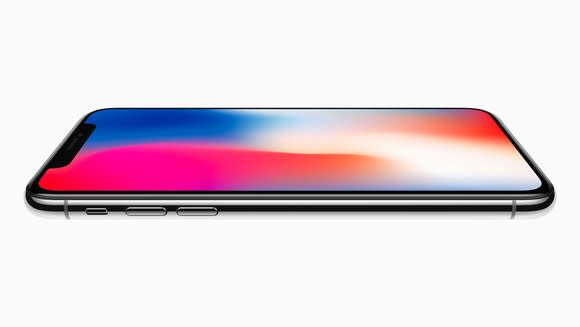3 Ways Apple Inc. Can Improve the iPhone X's Screen
In November 2017, Apple (NASDAQ: AAPL) began shipping its very first smartphone equipped with an organic light-emitting diode (OLED) panel -- iPhone X. Although the iPhone X hasn't been the commercial success that both Apple and many analysts had hoped, the device had, until very recently, arguably the best display that could be found on a smartphone.
However, with the launch of the Samsung (NASDAQOTH: SSNLF) Galaxy S9 series smartphones, the iPhone X's display has some stiff competition. The displays on the Galaxy S9 devices, according to testing performed by DisplayMate, bests the one found on the iPhone X in a number of ways, including color accuracy and viewing angles.

Image source: Apple.
Considering how important having leading display technology is to Apple, I think the odds are good that the company equips its next-generation iPhone X and iPhone X Plus smartphones with significantly enhanced displays.
Here are three ways that Apple could improve upon the iPhone X's display.
1. Faster refresh rate
One of the key selling points of the current iPad Pro tablets is the inclusion of a "ProMotion" display. Such a display can refresh its contents at up to 120 times per second -- twice that of previous iPad displays and current iPhone displays -- and the rate at which the display refreshes can vary with the speed of the content being viewed.
The higher refresh rate improves smoothness while the variable refresh rate helps to minimize power consumption and optimize battery life.
If Apple wants to offer customers a tangible reason to upgrade to new iPhones -- something that's proving increasingly difficult these days, considering the surprisingly poor performance of the iPhone X in the market -- then something like a faster refresh rate could do the trick. It's a feature that's instantly noticeable and something that customers can easily see for themselves when they try the devices out in store.
2. Improved color accuracy
During Apple's fall 2017 product launch event, the company touted that its Retina displays were the most color accurate in the industry. While the display on the iPhone X is extremely color accurate, it's still not quite perfect. Indeed, per DisplayMate's testing, the display found on the Galaxy S9 is actually more color accurate than the one found on the iPhone X.
Apple's been beaten at its own game.
It stands to reason, then, that Apple should aim to improve the color accuracy of its next-generation iPhone X displays even further in order to be able to once again credibly claim that its displays are the most color accurate in the industry.
3. Improved viewing angles
One of the issues with the current iPhone X display -- a flaw that's inherent to the iPhone X's display type -- is that when the screen is viewed off-axis, there is a dramatic color shift. While some degree of color shift is unavoidable on OLED displays, Apple's panels seem to be particularly bad about this.
According to DisplayMate's testing, the iPhone X's display sees much more severe color shifting than the display found on the Galaxy S9. This shows that there's room for Apple to improve -- and, frankly, improve dramatically -- on this relatively annoying aspect of the iPhone X in future models. The sooner Apple can deliver that improvement, the better it'll be for the competitive positioning of Apple's iPhone X series of smartphones.
More From The Motley Fool
Ashraf Eassa has no position in any of the stocks mentioned. The Motley Fool owns shares of and recommends Apple. The Motley Fool has the following options: long January 2020 $150 calls on Apple and short January 2020 $155 calls on Apple. The Motley Fool has a disclosure policy.
